Research on Disinformation in Academic Studies: Perspectives through a Bibliometric Analysis
Abstract
1. Introduction
2. Materials and Methods
- Journals, referring to publications: journal name, year of publication, language of publication, publisher, area of knowledge.
- Authors, which analyzes authorship: number of authors per publication, institutional affiliation and country of origin.
- Research (Systematic Study—50 most cited articles) on the content of the texts: subject matter, transdisciplinary, motivation, keywords, methodology and analysis techniques used.
3. Results
3.1. Journals
3.2. Authors
3.3. Research (Systematic Study—50 Most Cited Articles)
3.3.1. Journals
3.3.2. Authors
3.3.3. Methods
4. Discussion and Conclusions
Author Contributions
Funding
Data Availability Statement
Acknowledgments
Conflicts of Interest
References
- Pasławska, P.; Popielska-Borys, A. Phenomenon of Fake News. Soc. Commun. 2018, 4, 136–140. [Google Scholar] [CrossRef]
- Salaverría, R.; Cardoso, G. Future of disinformation studies: Emerging research fields. Prof. Inf. Inf. Prof. 2023, 32, 5. [Google Scholar] [CrossRef]
- Wilson, A.; Wilkes, S.; Teramoto, Y.; Hale, S. Multimodal analysis of disinformation and misinformation. R. Soc. Open Sci. 2023, 10, 230964. [Google Scholar] [CrossRef]
- Fallis, D. What is disinformation? Libr. Trends 2015, 63, 401–426. [Google Scholar] [CrossRef]
- Baines, D.; Elliott, R.J.R. Defining Misinformation, Disinformation and Malinformation: An Urgent Need for Clarity during the COVID-19 Infodemic; Discussion Papers, Article 20-06; Department of Economics, University of Birmingham: Birmingham, UK, 2020; Available online: https://ideas.repec.org//p/bir/birmec/20-06.html (accessed on 24 April 2024).
- Chan, J. Online astroturfing: A problem beyond disinformation. Philos. Soc. Crit. 2022, 50, 01914537221108467. [Google Scholar] [CrossRef]
- Akram, M.; Nasar, A.; Arshad-Ayaz, A. A Bibliometric Analysis of Disinformation through Social Media. Online J. Commun. Media Technol. 2022, 12, e202242. [Google Scholar] [CrossRef]
- Aïmeur, E.; Amri, S.; Brassard, G. Fake news, disinformation and misinformation in social media: A review. Soc. Netw. Anal. Min. 2023, 13, 30. [Google Scholar] [CrossRef]
- Cipers, S.; Meyer, T.; Lefevere, J. Government responses to online disinformation unpacked. Internet Policy Rev. 2023, 12, 1–19. [Google Scholar] [CrossRef]
- House of Commons. Disinformation and ‘Fake News’: Final Report; Digital, Culture, Media and Sport Committee; House of Commons: London, UK, 2019. [Google Scholar]
- United Nations. Countering Disinformation for the Promotion and Protection of Human Rights and Fundamental Freedoms: Report of the Secretary-General. 2022. Available online: https://digitallibrary.un.org/record/3987886 (accessed on 12 August 2022).
- Presidencia del Gobierno. Foro Contra las Campañas de Desinformación en el Ámbito de la Seguridad Nacional—Trabajos 2023; Gobierno de España. Sitio oficial del Departamento de Seguridad Nacional: Spain, 2023. Available online: https://www.dsn.gob.es/es/documento/foro-contra-campa%C3%B1as-desinformaci%C3%B3n-%C3%A1mbito-seguridad-nacional-trabajos-2023 (accessed on 24 April 2024).
- Puebla-Martínez, B.; Navarro-Sierra, N.; Alcolea-Díaz, G. Methodological Proposal for the Detection of the Composing Elements of Vulnerability Regarding Disinformation. Publications 2021, 9, 44. [Google Scholar] [CrossRef]
- Ceron, W.; de-Lima-Santos, M.-F.; Quiles, M.G. Fake news agenda in the era of COVID-19: Identifying trends through fact-checking content. Online Soc. Netw. Media 2021, 21, 100116. [Google Scholar] [CrossRef]
- Chung, M.; Kim, N. When I Learn the News is False: How Fact-Checking Information Stems the Spread of Fake News Via Third-Person Perception. Hum. Commun. Res. 2021, 47, 1–24. [Google Scholar] [CrossRef]
- Kozik, R.; Mazurczyk, W.; Cabaj, K.; Pawlicka, A.; Pawlicki, M.; Choraś, M. Deep Learning for Combating Misinformation in Multicategorical Text Contents. Sensors 2023, 23, 9666. [Google Scholar] [CrossRef] [PubMed]
- Dame Adjin-Tettey, T. Combating fake news, disinformation, and misinformation: Experimental evidence for media literacy education. Cogent Arts Humanit. 2022, 9, 2037229. [Google Scholar] [CrossRef]
- Donthu, N.; Kumar, S.; Mukherjee, D.; Pandey, N.; Lim, W.M. How to conduct a bibliometric analysis: An overview and guidelines. J. Bus. Res. 2021, 133, 285–296. [Google Scholar] [CrossRef]
- Paul, J.; Barari, M. Meta-analysis and traditional systematic literature reviews—What, why, when, where, and how? Psychol. Mark. 2022, 39, 1099–1115. [Google Scholar] [CrossRef]
- Wang, S.; Su, F.; Ye, L.; Jing, Y. Disinformation: A Bibliometric Review. Int. J. Environ. Res. Public Health 2022, 19, 16849. [Google Scholar] [CrossRef] [PubMed]
- Bran, R.; Tiru, L.; Grosseck, G.; Holotescu, C.; Malita, L. Learning from Each Other—A Bibliometric Review of Research on Information Disorders. Sustainability 2021, 13, 10094. [Google Scholar] [CrossRef]
- Romaní, F.; Huamaní, C.; González-Alcaide, G. Estudios bibliométricos como línea de investigación en las Ciencias Biomédicas: Una aproximación para el pregrado. Ciencia e Investigación Medico Estudiantil Latinoamericana. 2022, 16, 52–62. [Google Scholar]
- Bordons, M.; Zulueta, M.Á. Evaluación de la actividad científica a través de indicadores bibliométricos. Rev. Española Cardiol. 1999, 52, 790–800. [Google Scholar] [CrossRef]
- Angarita Becerra, L.D. Estudio bibliométrico sobre uso de métodos y técnicas cualitativas en investigación publicada en bases de datos de uso común entre el 2011–2013. Rev. Iberoam. Psicol. 2014, 7, 2. [Google Scholar] [CrossRef]
- Petticrew, M.; Roberts, H. Systematic Reviews in the Social Sciences: A Practical Guide, 1st ed.; Wiley: Hoboken, NJ, USA, 2006. [Google Scholar] [CrossRef]
- Avenali, A.; Daraio, C.; Di Leo, S.; Matteucci, G.; Nepomuceno, T. Systematic reviews as a metaknowledge tool: Caveats and a review of available options. Int. Trans. Oper. Res. 2023, 30, 2761–2806. [Google Scholar] [CrossRef]
- Polanco, X. Infometría e ingeniería del conocimiento: Exploración de datos y análisis de la información en vista del descubrimiento de conocimientos. In El Universo de la Medición: La Perspectiva de la Ciencia y la Tecnología. COLCIENCIAS, CYTED, RICYT: Segundo Taller Iberoamericano Sobre Indicadores en Ciencia y Tecnología; Jaramillo, H.; Albornoz, M., Translators; Tercer Mundo Editores: Santa Fe de Bogotá, Colombia, 1997; pp. 335–350. [Google Scholar]
- Crandford, S. The decline of Academic Auteur. Matter 2020, 2, 507–510. [Google Scholar] [CrossRef]


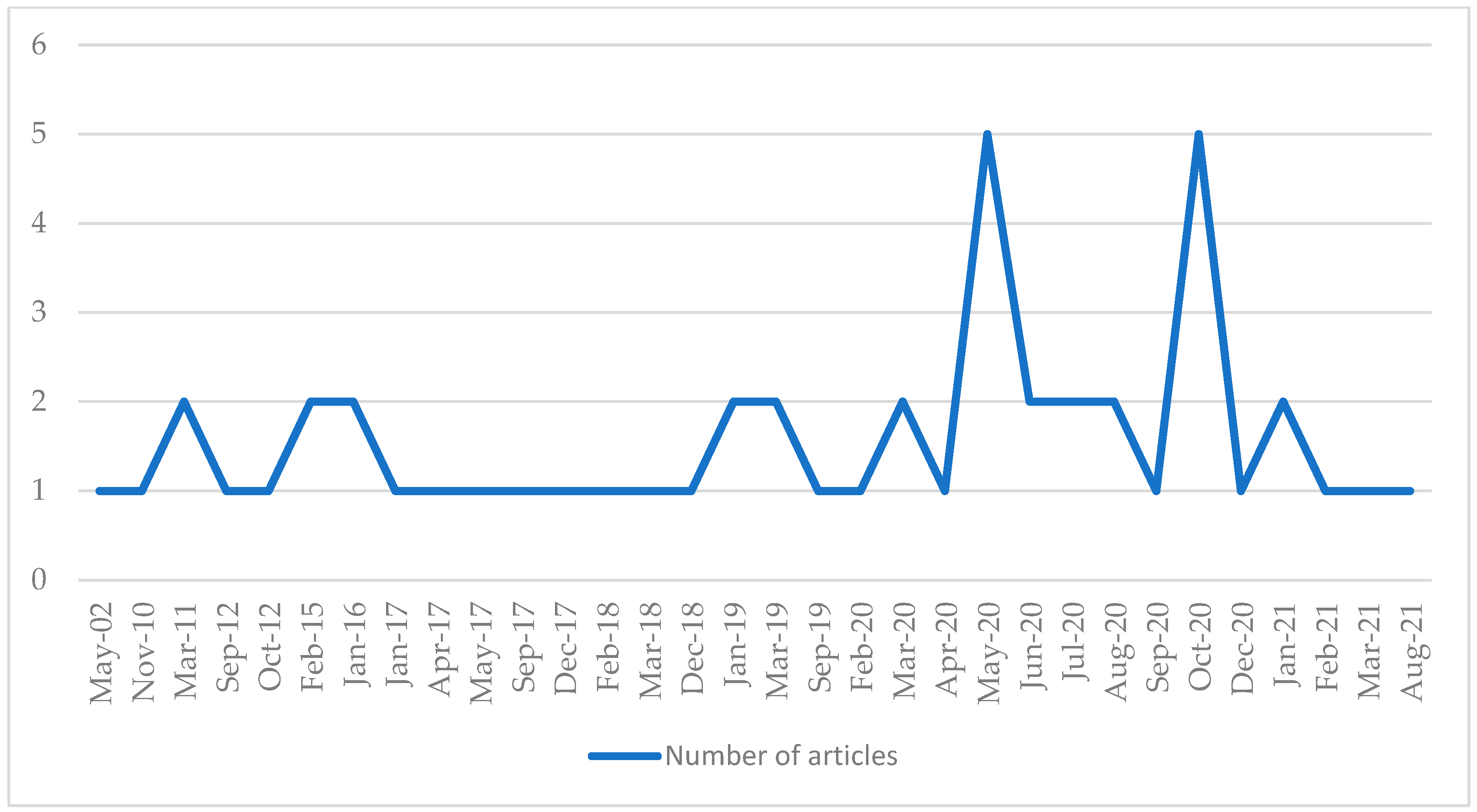
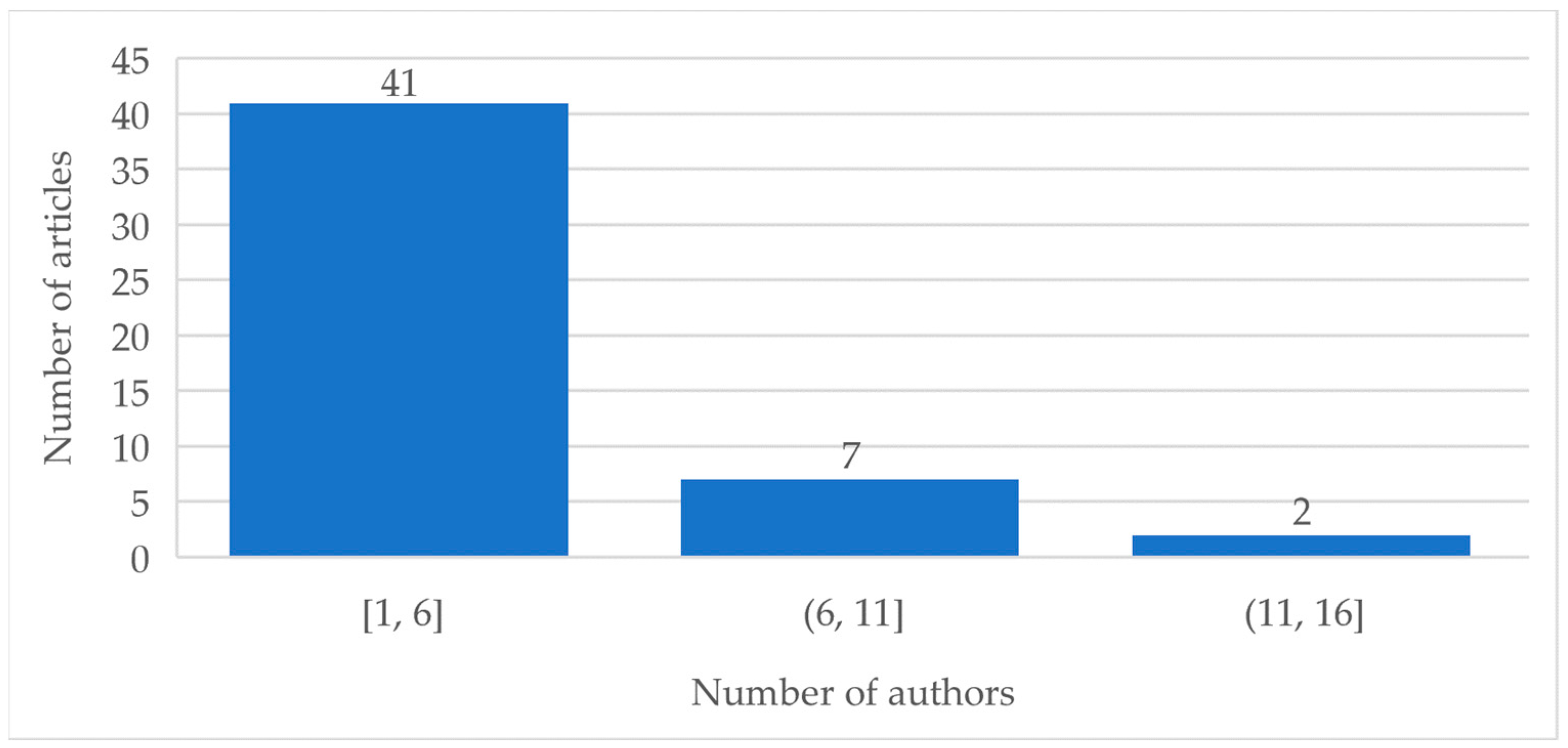
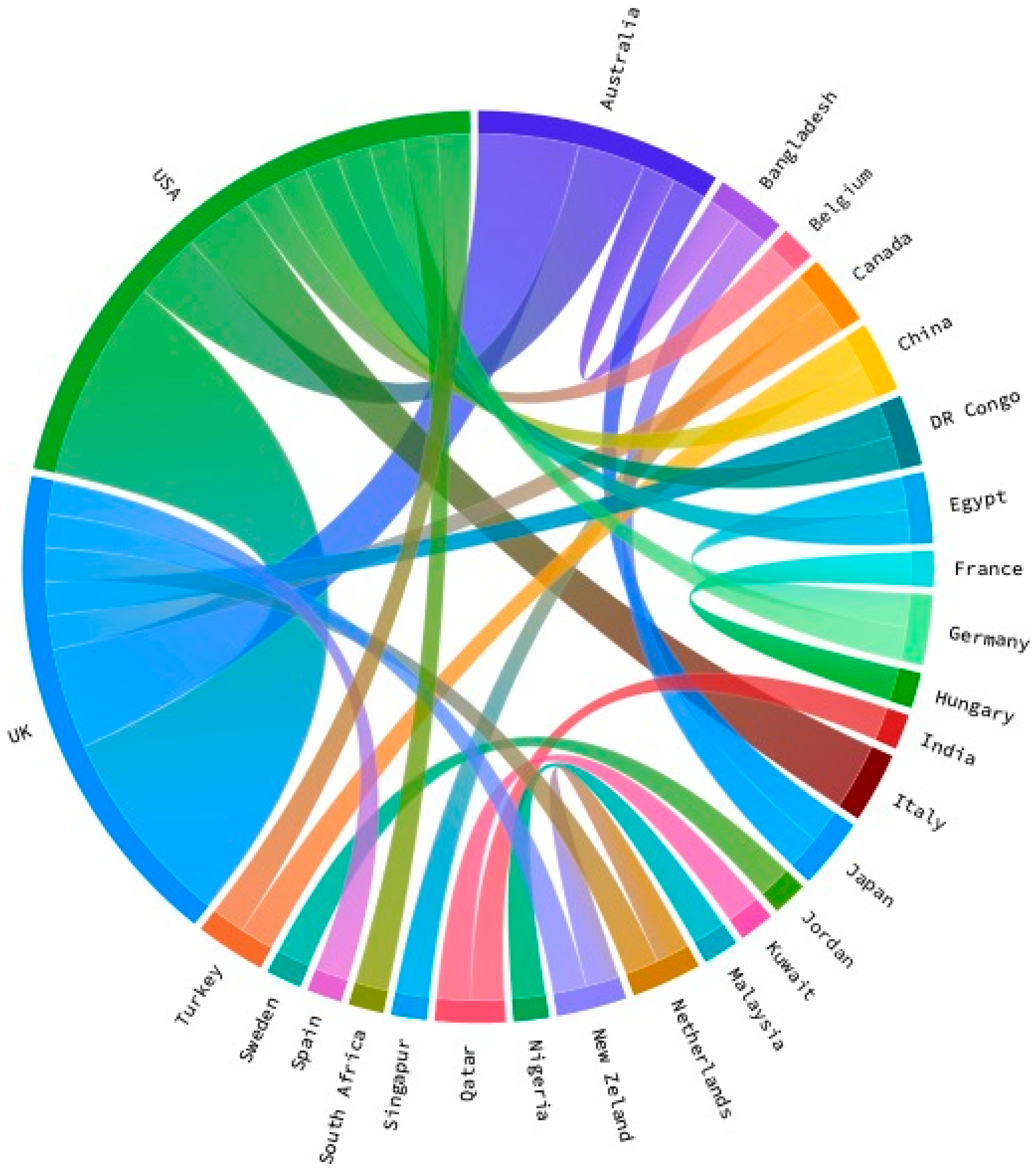
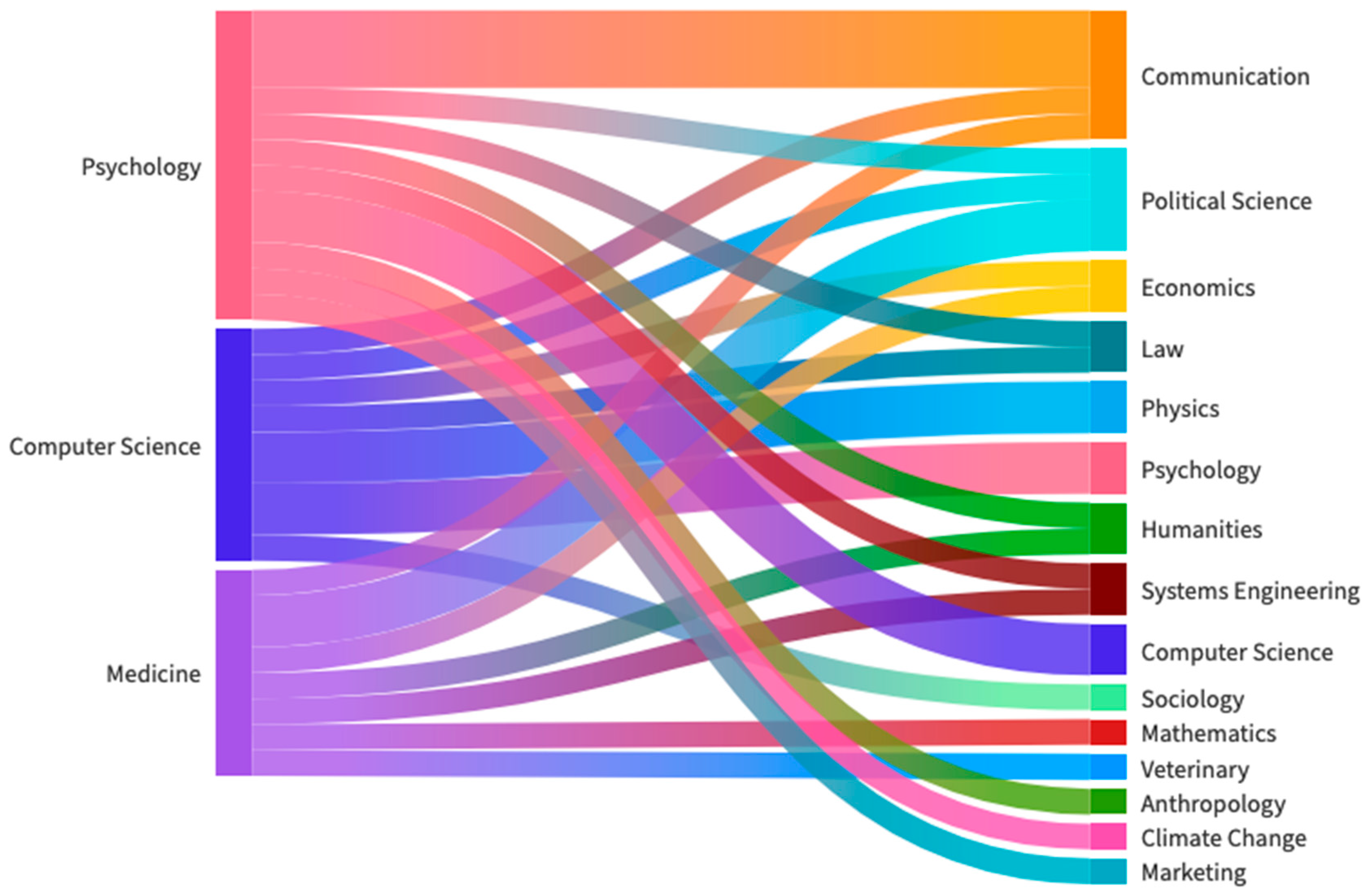

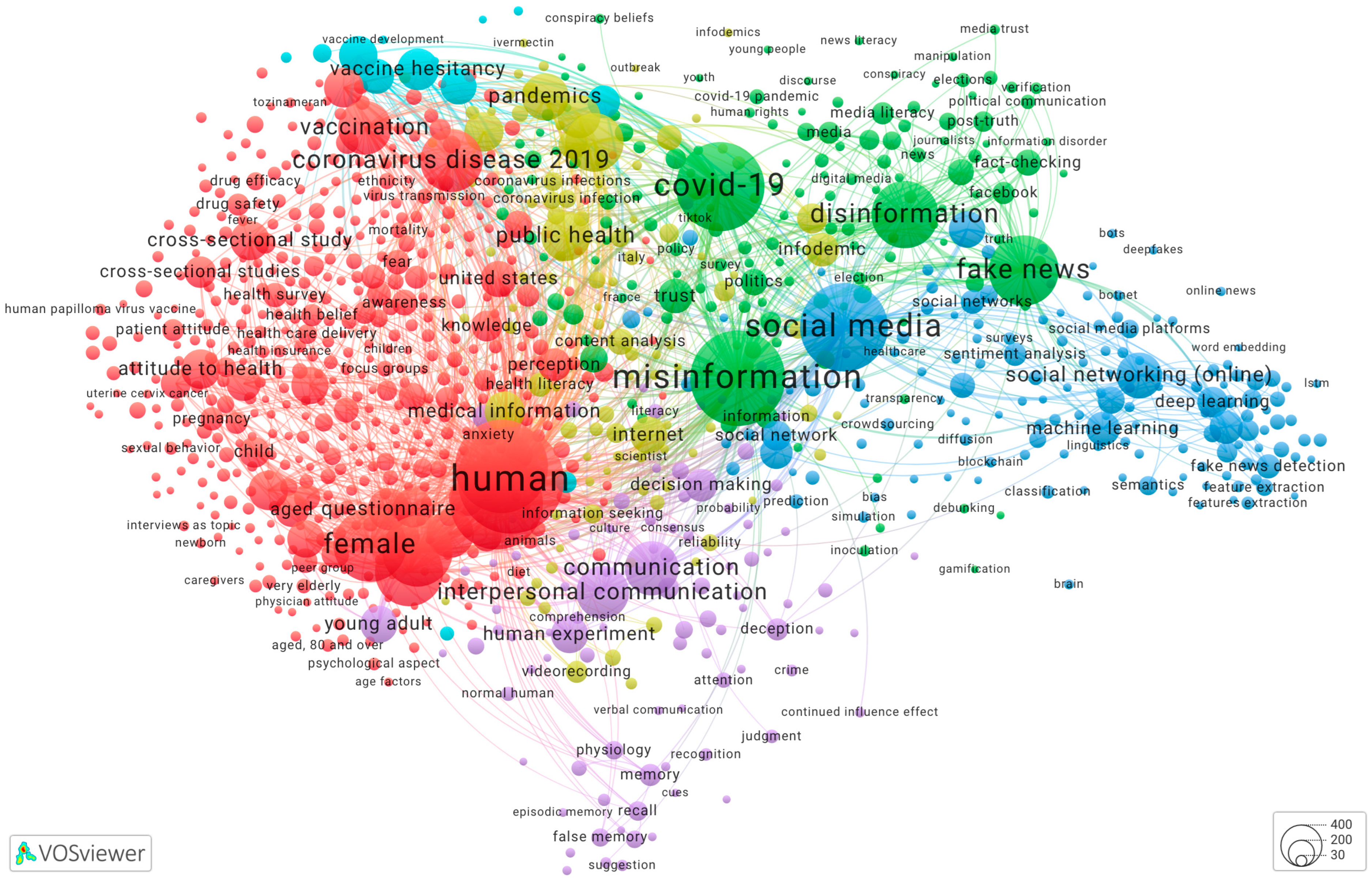
| # | Name | Docs | Country | Publisher | Language | Subject Area |
|---|---|---|---|---|---|---|
| 1 | PLOS One | 203 | United States | PLOS | English | Multidisciplinary |
| 2 | International Journal of Environmental Research and Public Health | 161 | Switzerland | MDPI | English | Medicine, Environmental Science |
| 3 | Journal of Medical Internet Research | 135 | Canada | JMIR Publications Inc. | English | Medicine |
| 4 | IEEE Access | 107 | United States | IEEE | English | Engineering, Computing Science, Materials Science |
| 5 | Vaccines | 92 | Switzerland | MDPI | English | Medicine, Pharmacology, Immunology |
| 6 | Social Media and Society | 86 | United Kingdom | SAGE | English | Social Sciences: Cultural Studies, Communication, Computing Science |
| 7 | Profesional de la Información | 85 | Spain | El profesional de la información | English, Spanish | Social Sciences, Communication, Library and Information Sciences |
| 8 | Harvard Kennedy School Misinformation Review | 80 | United States | Harvard Kennedy School | English | Social Sciences |
| 9 | Scientific Reports | 78 | Germany | Springer Nature | English | Multidisciplinary |
| 10 | Frontiers in Public Health | 71 | Switzerland | Frontiers Media | English | Medicine: Public Health, Environment and Occupational Health |
| 11 | Media and Communication | 70 | Portugal | Cogitatio Press | English | Social Sciences: Communication |
| 12 | Frontiers in Psychology | 64 | Switzerland | Frontiers Media | English | Psychology |
| 13 | BMC Public Health | 62 | Germany | Springer Nature | English | Medicine: Public Health, Environment and Occupational Health |
| 14 | Proceedings of the ACM on Human–Computer Interaction | 54 | United States | Association for Computing Machinery | English | Social Sciences, Computing Science |
| 15 | Human Vaccines and Immunotherapeutics | 50 | United Kingdom | Taylor & Francis | English | Pharmacology, Medicine, Immunology |
| 16 | Proceedings of The National Academy of Sciences of The United States of America | 46 | United States | National Academy of Sciences | English | Multidisciplinary |
| 17 | BMJ Open | 45 | United Kingdom | BMJ Publishing Group | English | Medicine |
| 18 | Jmir Formative Research | 44 | Canada | JMIR Publications Inc. | English | Medicine |
| 19 | Vaccine | 44 | Netherlands | Elsevier | English | Veterinary, Medicine, Immunology |
| 20 | Jmir Infodemiology | 41 | Canada | JMIR Publications Inc. | English | Medicine, Computing Science |
| 21 | Estudios Sobre El Mensaje Periodístico | 40 | Spain | Universidad Complutense de Madrid | English, Spanish | Social Sciences: Cultural Studies, Communication |
| 22 | Applied Cognitive Psychology | 39 | United States | Wiley-Blackwell | English | Arts and Humanities, Psychology |
| 23 | Applied Sciences Switzerland | 38 | Switzerland | MDPI | English | Engineering, Physics and Astronomy Materials Science, Chemical Engineering |
| 24 | Frontiers In Communication | 38 | Switzerland | Frontiers Media | English | Social Sciences, Communication |
| 25 | New Media and Society | 37 | United Kingdom | SAGE | English | Social Sciences: Sociology, Communication |
| # | Author | Affiliation | Country | Subject Area | Gender | Disinf. docs | Total docs | % |
|---|---|---|---|---|---|---|---|---|
| 1 | Ecker, U.K.H. | The University of Western Australia | Australia | Psychology | Male | 44 | 111 | 40% |
| 2 | Lewandowsky, S. | University of Bristol | United Kingdom | Psychology | Male | 41 | 281 | 15% |
| 3 | Hameleers, M. | University of Amsterdam | Netherlands | Communication | Male | 32 | 87 | 37% |
| 4 | Loftus, E.F. | University of California | United States | Psychology | Female | 31 | 356 | 9% |
| 5 | Rand, D.G. | Massachusetts Institute of Technology (MIT) | United States | Psychology | Male | 31 | 225 | 14% |
| 6 | Pennycook, G. | Cornell University | United States | Psychology | Male | 29 | 118 | 25% |
| 7 | van der Linden, S. | University of Cambridge | United Kingdom | Psychology | Male | 23 | 171 | 13% |
| 8 | Roozenbeek, J. | University of Cambridge | United Kingdom | Psychology | Male | 21 | 40 | 53% |
| 9 | Otgaar, H. | Maastricht University | Netherlands | Psychology | Male | 20 | 223 | 9% |
| 10 | Menczer, F. | Indiana University | United States | Computing Science | Male | 17 | 187 | 9% |
| 11 | Nyhan, B. | Darmouth College | United States | Political Science | Male | 17 | 79 | 22% |
| 12 | Carley, K.M. | Carnegie Mellon University | United States | Computing Science | Female | 15 | 458 | 3% |
| 13 | Ferrara, E. | University of Southern California | United States | Computing Science | Male | 13 | 187 | 7% |
| 14 | Quattrociocchi, W. | Sapienza Universitá di Roma | Italy | Computing Science | Male | 13 | 78 | 17% |
| 15 | Swire-Thompson, B. | Northeastern University | United States | Political Science and Psychology | Female | 13 | 27 | 48% |
| 16 | Altay, S. | University of Oxford | United States | Political Science | Male | 13 | 28 | 46% |
| 17 | Reifler, J. | University of Exeter | United Kingdom | Political Science | Male | 12 | 86 | 14% |
| 18 | Jamieson, K.H. | University of Pennsylvania | United States | Communication | Female | 12 | 183 | 7% |
| 19 | Murphy, G. | University College Cork | Ireland | Psychology | Female | 12 | 47 | 26% |
| 20 | Cook, J. | University of Melbourne | Australia | Psychology | Male | 11 | 55 | 20% |
| 21 | Chadwick, A. | Loughborough University | United Kingdom | Communication | Male | 11 | 43 | 26% |
| 22 | Vaccari, C. | The University of Edinburgh | United Kingdom | Political Science | Male | 11 | 65 | 17% |
| 23 | Chan, J.C.K. | Iowa State University | United States | Psychology | Male | 11 | 35 | 31% |
| 24 | Greene, C.M. | University College Dublin | Ireland | Psychology | Female | 11 | 58 | 19% |
| 25 | Bastos, M. | University College Dublin | Ireland | Communication | Male | 10 | 44 | 23% |
| 474 | 3272 |
| # | University | Country | Number of Articles |
|---|---|---|---|
| 1 | University of Oxford | United Kingdom | 100 |
| 2 | Universiteit van Amsterdam | Netherlands | 89 |
| 3 | The University of Western Australia | Australia | 73 |
| 4 | University of Pennsylvania | United States | 69 |
| 5 | Harvard University | United States | 68 |
| 6 | University of Toronto | Canada | 68 |
| 7 | University of Michigan, Ann Arbor | United States | 68 |
| 8 | London School of Hygiene & Tropical Medicine | United Kingdom | 68 |
| 9 | University of Washington | United States | 67 |
| 10 | University College London | United Kingdom | 67 |
| 11 | Massachusetts Institute of Technology | United States | 67 |
| 12 | The University of Sydney | Australia | 66 |
| 13 | University of Cambridge | United Kingdom | 66 |
| 14 | Harvard Medical School | United States | 65 |
| 15 | Stanford University | United States | 65 |
| 16 | Universidade de São Paulo | Brazil | 62 |
| 17 | Universidad Complutense de Madrid | Spain | 59 |
| 18 | University of Bristol | United Kingdom | 58 |
| 19 | The University of North Carolina at Chapel Hill | United States | 58 |
| 20 | University of California, Irvine | United States | 52 |
| 21 | Universität Zürich | Switzerland | 47 |
| 22 | National University of Singapore | Singapore | 47 |
| 23 | Universidad Rey Juan Carlos | Spain | 47 |
| 24 | Indiana University Bloomington | United States | 47 |
| 25 | University of California, San Francisco | United States | 47 |
| ID | Title | SCIVAL Topics | Prominence % | FWCI |
|---|---|---|---|---|
| 1 | COVID-19 and mental health: A review of the existing literature | Psychological Support; Mindfulness; COVID-19 | 99.996 | 172.95 |
| 2 | Measuring the impact of COVID-19 vaccine misinformation on vaccination intent in the UK and USA | Vaccine Hesitancy; Measles; Anti-Vaccination Movement | 99.970 | 111.78 |
| 3 | Conspiracy theories as barriers to controlling the spread of COVID-19 in the U.S. | Conspiracy Theory; Mentality; COVID-19 | 99.244 | 88.44 |
| 4 | Fighting COVID-19 Misinformation on Social Media: Experimental Evidence for a Scalable Accuracy-Nudge Intervention | Rumor; Social Media: Disinformation | 99.819 | 70.73 |
| 5 | Vaccine hesitancy: the next challenge in the fight against COVID-19 | Vaccine Hesitancy; Measles; Anti-Vaccination Movement | 99.970 | 66.60 |
| 6 | A Comprehensive Review of the COVID-19 Pandemic and the Role of IoT, Drones, AI, Blockchain, and 5G in Managing its Impact | Bitcoin; Ethereum; Internet of Things | 99.989 | 64.83 |
| 7 | The science of fake news: Addressing fake news requires a multidisciplinary effort | NO DATA | NO DATA | 61.70 |
| 8 | High rates of COVID-19 vaccine hesitancy and its association with conspiracy beliefs: A study in Jordan and Kuwait among other Arab countries | Vaccine Hesitancy; Measles; Anti-Vaccination Movement | 99.970 | 49.40 |
| 9 | Health-protective behaviour, social media usage and conspiracy belief during the COVID-19 public health emergency | Conspiracy Theory; Mentality; COVID-19 | 99.244 | 46.18 |
| 10 | A Survey of Fake News: Fundamental Theories, Detection Methods, and Opportunities | Rumor; Social Media: Disinformation | 99.819 | 45.41 |
| Topic | N° Articles | Number of Quotes | Average |
|---|---|---|---|
| Health and COVID | 22 | 13,926 | 633 |
| Fake News | 3 | 4311 | 1437 |
| Disinformation and Social Networks | 6 | 4280 | 713.33 |
| Psychology | 5 | 2958 | 591.6 |
| Disinformation and Politics | 4 | 1979 | 494.75 |
| Disinformation and Technology | 4 | 1838 | 459.5 |
| Health and H1N1 flu | 1 | 1162 | 1162 |
| Disinformation and Climate Change | 2 | 893 | 446.5 |
| Health and HIV | 1 | 658 | 658 |
| Health and Ebola | 1 | 331 | 331 |
| Health, COVID and Politics | 1 | 325 | 325 |
| Field 1 | Articles in the Sample | Collaborative Articles (with One or More Fields) |
| Psychology | 14 | 7 |
| Medicine | 14 | 7 |
| Computer Science | 12 | 7 |
| Communication | 8 | 4 |
| Political Science | 7 | 4 |
| Systems Engineering | 5 | 2 |
| Physics | 3 | 3 |
| Economics | 2 | 2 |
| Humanities | 2 | 2 |
| Mathematics | 2 | 2 |
| Anthropology | 1 | 1 |
| Climate Change | 1 | 1 |
| Law | 1 | 1 |
| Marketing | 1 | 1 |
| Sociology | 1 | 1 |
| Veterinary | 1 | 1 |
Disclaimer/Publisher’s Note: The statements, opinions and data contained in all publications are solely those of the individual author(s) and contributor(s) and not of MDPI and/or the editor(s). MDPI and/or the editor(s) disclaim responsibility for any injury to people or property resulting from any ideas, methods, instructions or products referred to in the content. |
© 2024 by the authors. Licensee MDPI, Basel, Switzerland. This article is an open access article distributed under the terms and conditions of the Creative Commons Attribution (CC BY) license (https://creativecommons.org/licenses/by/4.0/).
Share and Cite
Navarro-Sierra, N.; Magro-Vela, S.; Vinader-Segura, R. Research on Disinformation in Academic Studies: Perspectives through a Bibliometric Analysis. Publications 2024, 12, 14. https://doi.org/10.3390/publications12020014
Navarro-Sierra N, Magro-Vela S, Vinader-Segura R. Research on Disinformation in Academic Studies: Perspectives through a Bibliometric Analysis. Publications. 2024; 12(2):14. https://doi.org/10.3390/publications12020014
Chicago/Turabian StyleNavarro-Sierra, Nuria, Silvia Magro-Vela, and Raquel Vinader-Segura. 2024. "Research on Disinformation in Academic Studies: Perspectives through a Bibliometric Analysis" Publications 12, no. 2: 14. https://doi.org/10.3390/publications12020014
APA StyleNavarro-Sierra, N., Magro-Vela, S., & Vinader-Segura, R. (2024). Research on Disinformation in Academic Studies: Perspectives through a Bibliometric Analysis. Publications, 12(2), 14. https://doi.org/10.3390/publications12020014







